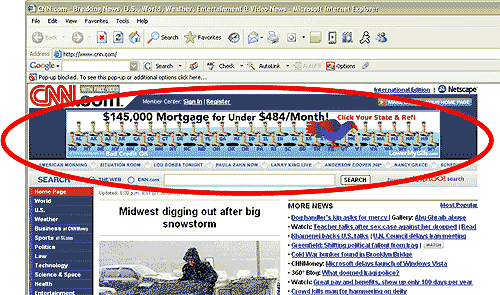


Page 7/12 |
Banner Advertisements
Anyone who has surfed the web has most likely seen a banner advertisement. These are the advertisements for businesses or products other than what you are currently viewing. They typically appear along the sides or at the top of a website or page, such as the one below at the top of CNN's website.

While some may think that banner advertisements are annoying, they can be a useful advertising tool if used wisely. Keys to using banner advertisements wisely include having a sharp looking banner and getting your banner onto websites and webpages that your target audience would typically be visiting. Recall that a website consists of one or more web pages. When you develop your own website you will probably have more than one page, with the topic/content of each page being unique.
So, on what websites/pages should advertise your website? Consider your target customer. What other websites are they visiting? What other products are they purchasing or would they be interested in? Does your product or service compliment another that your target customer may be purchasing? What websites do you visit when performing business research or looking to make your own purchases? These are the websites and pages where you should place your banner ads. For example, a banner ad for your custom forage harvesting service will be much more effective on an article page about forage quality than on a page about investment strategies. The target customer for a forage harvesting service may be researching how to improve forage quality and seeing your ad may encourage them to investigate your custom harvesting services.
There are two basic ways to have your banners placed on other websites/pages. The first is to pay for placement. Placement is usually priced by the number of views and/or click-throughs. A "view" is when your banner is displayed, or seen, on another website. Click-throughs occur when someone actually clicks on the banner and is taken to your website. The other way to have your banners placed is through a banner exchange. There are several ad banner networks through which you can participate in a banner exchange. The banner exchange service will give you HTML code to place on your website. From that code, other businesses participating in the banner exchange will have their banners appear on your website. In return, your banner advertisement will appear on other participants' sites. Some free banner exchange services include e-bannerx.com and tradebannerads.com. Most banner exchange services offer an exposure ratio of 2:1, meaning that for every 2 visitors to a site, you get 1 exposure. Another common ratio is 3:2, so for every 3 visitors, you'd have 2 exposures. However, this may not be a good option since some people tend to be turned off by banner ads, and you might not want to have ads for other businesses on your website.Page 7/12 |
Web site and all contents © Copyright SRDC 2009, All rights reserved. |
|
| These materials were developed as part of the Southern Rural Development Center’s National e-Commerce Extension Initiative. They are based upon work supported by the Cooperative State Research, Education, and Extension Service, U.S. Department of Agriculture, under Award No. 2005-45064-03212 Any opinions, findings, conclusions, or recommendations expressed in this publication are those of the author(s) and do not necessarily reflect the view of the U.S. Department of Agriculture or the Southern Rural Development Center. |
|